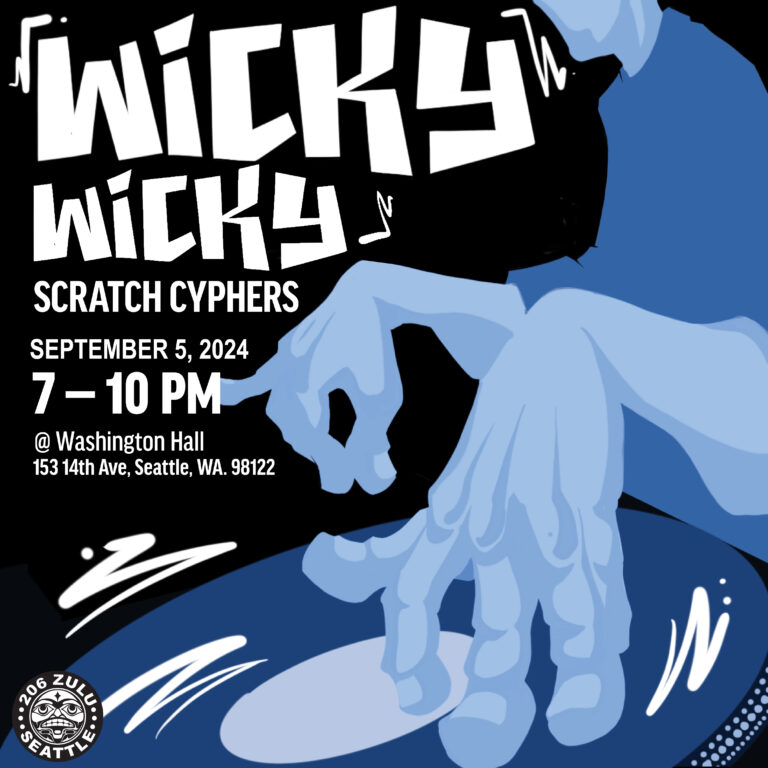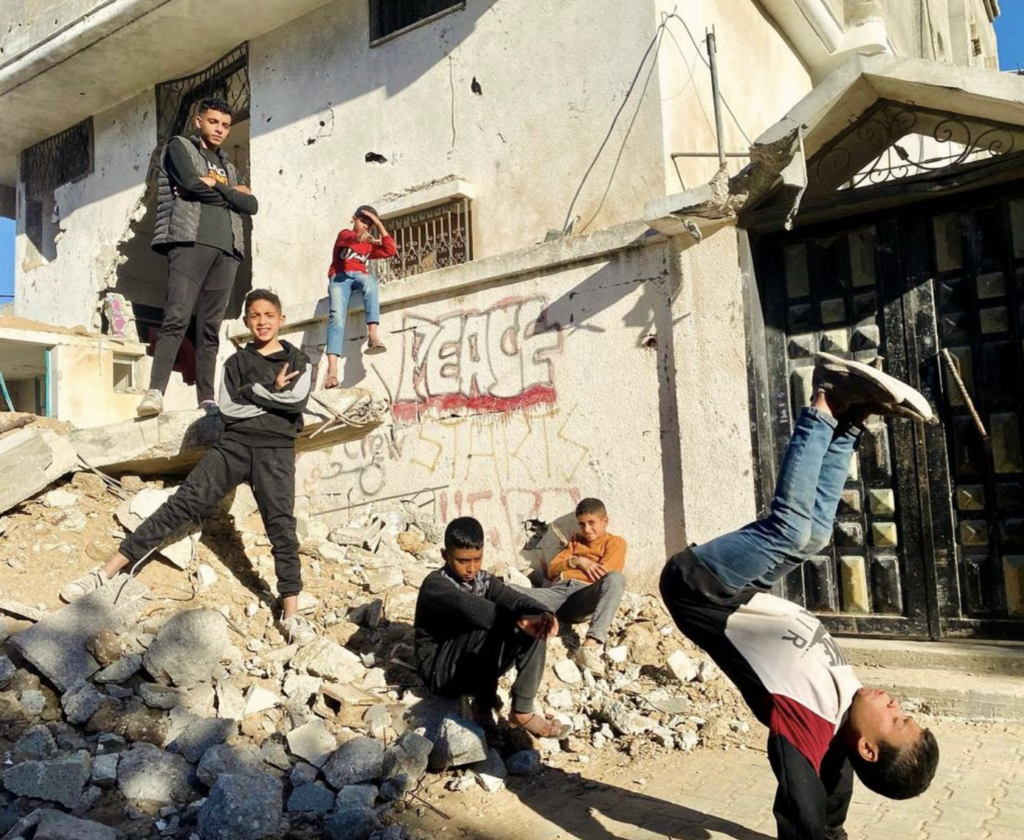Thursday, September 5, 2024
WICKY WICKY
Scratch Session at Washington Hall
Washington Hall
153 14th Ave
Seattle, WA 98122
Free | 7-10pm | All-Ages
RSVP
Wicky Wicky
Always Remembered 2023- Bill Lee and the Mo’ Better Blues
Some 206 Zulu readers will be familiar with our Always Remembered series, a tradition we carry each year where we take time to hold space for people within Hip Hop and its peripheral communities who passed on over the course of the preceding year. In the past, this remembrance has taken the form of an annual video episode of our Meeting of the Minds podcast. For 2024, we’ll be sharing these memories in a different way.
Over the course of this year, we’ll be sharing a written commemoration of some of these influential members of our greater community, one at a time. We know that the act of remembrance is a tremendous power we have to keep our predecessors and ancestors alive through our collective voice. In that grain, keep posted for our ongoing series of brief stories looking into the lives of some of the fascinating people that transcended their physical frames in the course of 2023. And if any of these individuals have impacted you in any way, remember, your retelling of these stories will keep them alive in perpetuity. This is Always Remembered…

Bill Lee
William James Edwards Lee III aka Bill Lee was known for many things in his long life. He was a jazz bassist who played his double bass with an eclectic host of pivotal figures in music history not often found on the same list. He collaborated with artists whose names have become iconic in genres ranging from jazz and soul to rock and folk music. Some of those names include Duke Ellington, Bob Dylan, Harry Belafonte, Aretha Franklin, and Peter, Paul, and Mary. He’s also known for the work that he did with his son, the filmmaker Spike Lee. Bill died in his home in Brooklyn on May 24, 2023 at the age of 94.
Over the course of his life, Bill Lee worked extensively with his son, beginning with Spike Lee’s film-school thesis project, Joe’s Bed-Stuy Barbershop: We Cut Heads. He would go on to write the soundtracks for Spike Lee’s first four feature films, She’s Gotta Have It (1986), School Daze (1988), Do the Right Thing (1989), and the story of hardships in the life of a jazz musician in Mo’ Better Blues (1990).
In an interview once, Spike said about his father, “I saw his integrity, how he was not going to play just any kind of music, no matter how much money he could make.”
We remember Bill Lee not only for his own accomplishments and innovations in the music he wrote and performed, but he also provides a contemplation on how we regard the parents of famous artists. A son of two musicians himself, he along with his wife Jacquelyn Lee who died of cancer at the early age of 41, passed the love of the arts along to their children. Along with finding joy in art, he held a line which represents a precedent for music to mean more than financial profit or public accolades. The act of keeping art and freedom alive through generations of a family line is an incredible accomplishment in itself. Doing so in a way that passes values along with the art is a potential gift to the future. As we inherit that world, we remember Bill Lee.
Preserve the Kulture Jam 24
Preserve the Kulture Jam 24 is a two-day celebration of hip-hop culture at APEX Art & Culture Center, Friday and Saturday, Aug. 16-17!
FRIDAY, AUG. 16
PTK kicks off Friday with a special movie screening of “Prophets, Teachers and Kings,” an award-winning film that’s an inside look at the dark and sometimes dangerous world of one of Los Angeles’ oldest graffiti crews, and their 35-year rise from juvenile delinquency to urban art infamy.
There will be an exciting panel following the film with John Carswell, collector of the DogTown Collection; Devin Rice, movie director and cinematographer; AYE147, renowned UTI graffiti writer and DogTown artist; Cornbread, the Philadelphia graffiti legend credited as the world’s first graffiti artist; and Baby G Carswell, AMGRAF curator. This is a not-to-be-missed event.
After the panel there will be an unveiling of a special canvas painted by Cornbread, as well as tours of the AMGRAF museum with Baby G.
SATURDAY, AUG. 17
Saturday will be an action-packed day showcasing “the Kulture” of Hip Hop.
The morning begins with the start of the children’s mural project at the back wall of APEX. AYE147 and Cornbread will collaborate on this fun mural that will grace the wall for the year, spreading a message of unity, kindness and hope.
We will close Wetmore Avenue between Everett and 26th Street for a lowrider car show highlighting local clubs and the drivers’ ability to turn cars into not only pieces of art, but also engineering feats with out-of-this-world hydraulics.
That afternoon, 206 Zulu, the Seattle-based community organization that uses Hip Hop culture and the arts as platforms for community service, education and empowerment, will host a Zulu Throwdown breakdancing workshop, exhibition and break battle.
Watch some of graffiti’s top national and regional artists compete in our annual paint battle; battling to be the best of their peers and crowd favorites. Meet the artists and watch their creativity flow from can to canvas.
DJs will keep the vibe going, Johnny Slaw’s will keep bellies full, and our beer and wine garden will be sure to keep adult beverages flowing.
Phoenix-based Herb ‘N Life will play Kings Hall at 8 p.m. Created in 2020, this reggae rock band released their first album – The Blue Album – in October 2022. They hae a distinct sound and are sure to get showgoers dancing.
*There will be a $10 cover charge to enter Kings Hall for the Saturday night show beginning at 8 p.m. The beer garden and food truck will be open throughout the event.
Supported by Snohomish County and Everett LTAC grants, this community event is partnering with 206 Zulu and The Schack Art Center and Schack’s Fresh Paint event. Paint, paint and more paint. Watching graffiti artists create their works of art using only aerosol paint doesn’t get much fresher.
Location: APEX Everett
1611 Everett Avenue
Everett, WA 98201
Stay tuned for more updates!
13th Annual Beat Masters
What an incredible weekend at Beat Masters! @206zulu captured the electrifying moments where music producers battled it out for the best beats. Huge congratulations to @thirdeyebling for taking the 2024 Beat Masters champion title! 🏆
A massive shoutout to our guest judges @maraire @dume41 and @djqbert for making the tough calls. We’re honored to have had Qbert in the house, delivering a stellar show despite the technical issues. 🙌
Thank you to our amazing host @seattleskey and to all the incredible performers and supporters: @oh__my__kaz Kitty Wu, @mzmusicgirl anticolonialauntie, @djwray206, @jazrupt @dj_neebor @scottbreitbarth @digislaps, and everyone else who made this event a success!
Big thanks to @downtownseattle for partnering with us to make this event happen! 🎉
Special shoutout to @djqbert @djtecumseh , Chad Joshua, @djshmix and all the turntablists who came afterwards for the amazing scratch session. 🎧✨
206 Zulu presents:
The 13th ANNUAL BEAT MASTERS BEAT BATTLE
DEADLINE TO ENTER: Sunday, July 21st
Sunday, July 28th, 2024 (2:00pm-7:00pm)
$1,000 GRAND PRIZE BEAT BATTLE
$500 – 2nd Place
Judges: DJ Qbert, Baba Maraire, Dume41
Performances by DJ Qbert, Beatbox Panda
Bboy/Bgirl Cypher, Beat Cypher
Hosted by Seattle’s Key
DATE OF EVENT
Sunday, July 28, 2024
2:00-7:00pm
LOCATION
Westlake Park (Downtown)
401 Pine St, Seattle, WA
TIME
Event starts at 2pm. Sign in is at 2:00pm, please arrive no later than 2:30pm. Beat Battle will begin at 3pm promptly.
Note: Parking may be difficult to find, please plan ample time to get to location.
FORMAT
Out of all online submissions, 16 will be selected. Those chosen will be given an opportunity to compete at the beat battle on Sunday, July 28th.
The 16 producers selected will be announced Wed. July, 24th.
Preliminary Round – (60 seconds) / 2 rounds each (16 producers)
1st Round – (60 seconds) / 2 rounds each (top 8 will go head to head)
Semi-finals – (60 seconds) / 2 rounds each (top 4 will go head to head)
Finals – (60 seconds) / 2 rounds each (head to head)
Preliminary round: Each producer plays two beats at exactly 60 seconds.
The top 8 contestants will be chosen to compete head to head. During the 1st round, each producer will play two beats at exactly 60 seconds.
4 semi-finalists will be chosen and compete head to head against another producer. Each producer will play 2 beats consecutively at exactly 60 seconds.
The top 2 finalists will compete for the champion title and $1,000!
The Beat Masters Beat Battle will take place outdoors at Westlake Park in downtown Seattle right in front Westlake Mall. Please only bring beats on a portable media player with a 1/8″ output. (such as iPod, laptop, tablet, mp3 player, etc)
Organizers and judges selected do not tolerate bias or discrimination in any form including association, affiliation, technical-preferences, creed, ethnicity, or gender. Leave egos at home. This is a positive event in the name of good spirited competition and artistic expression. No weapons, alcohol or drugs permitted on premises. All beats shall be free of profanity and/or sexually suggestive themes. Phrases/hooks can be be incorporated into production.
For questions/Info email: beatmastersbeatbattle@gmail.com
Sponsored by Downtown Seattle Association, Seattle Office of Arts & Culture, 4Culture, ArtsWA and National Endowment of the Arts.






Register below to compete!
Always Remembered 2023- Wayne Shorter and Life from This Moment Forward
Some 206 Zulu readers will be familiar with our Always Remembered series, a tradition we carry each year where we take time to hold space for people within Hip Hop and its peripheral communities who passed on over the course of the preceding year. In the past, this remembrance has taken the form of an annual video episode of our Meeting of the Minds podcast. For 2024, we’ll be sharing these memories in a different way.
Over the course of this year, we’ll be sharing a written commemoration of some of these influential members of our greater community, one at a time. We know that the act of remembrance is a tremendous power we have to keep our predecessors and ancestors alive through our collective voice. In that grain, keep posted for our ongoing series of brief stories looking into the lives of some of the fascinating people that transcended their physical frames in the course of 2023. And if any of these individuals have impacted you in any way, remember, your retelling of these stories will keep them alive in perpetuity. This is Always Remembered…

Wayne Shorter
Wayne Shorter could easily be called one of the forebears of Hip Hop culture, among many other musical movements that have been born from a sense of freedom and self-reflection. On the heels of a career in jazz that began when he was 19 years old, Wayne Shorter, one of the most dynamic and influential musicians in history, passed on last year at the age of 89.
From an industry perspective, Wayne was a 12 time Grammy Award-winning saxophonist and composer as well as the creator of one of the most unique sounds in jazz for more than half a century. From the bebop and hard bop eras in the 1950s, onto some of the most widely known music from jazz’s small-group period in the ‘60s, and then into the experimental era of rock and electronic sounds that the ‘70s ushered in, his soprano and tenor saxophones were a constant throughout.
Wayne Shorter was part of some of the most important groups and collaborations in jazz history, from playing with Art Blakey’s Jazz Messengers in the early years, to joining Miles Davis’ second quintet along with Ron Carter, Tony Williams, and Herbie Hancock. He recorded a range of classic albums on Blue Note Records with members of John Coltrane’s quartet, Freddie Hubbard, and more. After both artists work as architects of the genre shifting modal jazz sound, Wayne and Miles stuck together as they experimented with electronic instruments. Wayne would also later co-found Weather Report, one of the most influential jazz fusion bands of the ‘70’s.
His last album was a crazy multi-disc four movement suite that he made with a group of young musicians, along with a 34 piece chamber orchestra. In true form for one of the masters of fusing mediums, the record included a graphic novel attached to accompany the music. That album dropped in 2018, over 50 years after Wayne Shorter joined the Jazz Messengers, an end cap to those decades at the forefront of some of the most influential music ever made.
The final album was called Emanon, which is “no name” backwards- taken from a Dizzy Gillespie and Milton Shaw composition released in 1947. It’s also the name that Aloe Blacc and Exile used for their collaboration group, along with many other off chance Hip Hop connections to the earlier paths that Wayne Shorter carved for the freedom of expression that Hip Hop would carry on over the years.
In the 1970s, Wayne became a Buddhist and spent his subsequent years living out some of the best principles of that spiritual path. In an NPR interview in 2013 he said, “We have a phrase [in Buddhism]: hom nim yoh. It means ‘From this moment forward is the first day of my life.’ So put 100 percent into the moment that you’re in because the present moment is the only time when you can change the past and the future.”
We’ll take that example from him and continue to hold to our power of making change by living in the moment. For the affirmation of the power of freedom in art that he proved for musicians to come, and the artists walking the path he tread- from producers that sampled his work, to saxophonists playing in styles he created, to emcees improvising in the ultimate act of oneness with the present as we saw in Bodhisattva Wayne- we remember Wayne Shorter.
El Guanaco – En el Mercado ft. Sista Hailstorm (Official Video)
El Guanaco “En el Mercado” featuring Sista Hailstorm
Directed by El Guanaco and Nobe Inf Gang. Music Produced by Mr. Adrian. Mixed & Mastered by Dume41. Shot by Chad and MKY Visualz. Edited by Chad. El Guanaco “En el Mercado” from the album ‘La Historia’ on MADK Productions.
Listen to El Guanaco-
Amazon
Apple Music
Deezer
Spotify
YouTube
Follow-
Instagram
Facebook
#madkrew #206zulu #nwhiphop #seattlehiphop #lahiphop #oakland #bboying #lahistoria #latinhiphop #bboyworld
The Vinyl Keeps Spinning: Hip Hop’s Timeless Love Affair
Is it the gritty sound that digital recordings, promising to improve quality and accessibility, can’t quite replicate? Or the allure of holding a rare album in your hands- sliding the record out of the sleeve, holding it by its edges, lowering the needle, and watching the revolutions of the spinning disc? Perhaps it’s the nostalgia of a bygone era or the deeper connection it creates with the artist, where every crackle and pop tells its own story.

LA Record Fair:
This love for vinyl comes to life on the third Sunday of every month at the LA Record Fair. Here, the air buzzes with jazz, and melónamos (music lovers) have animated conversations amidst the colorful canopy of tents selling food, clothing, music, and other arts and crafts.
It all started in 2008 with Beat Swap Meet, a cornerstone of Los Angeles’ vinyl culture, a gathering of the minds, providing a space for music enthusiasts and truth seekers to gather, trade, and celebrate the enduring appeal of vinyl records.

The event has grown into a community tradition, and Beat Swap Meet now presents the LA Record Fair with over 30 vendors offering genre-spanning selections. Melónamos explore crates of vinyl, uncovering everything from classic rock albums to obscure cumbia records. Based on supply and demand, prices can range from $1 to $1000.
Aaron from Drip Tone Records, a vendor specializing in punk, metal, and hip hop, expressed his joy in returning to local LA gigs after extensive travel to music festivals nationwide:

“Music is about connection,” Aaron emphasized. “Something about this physical medium allows listeners to connect deeply with the artists. You can stream music for free online and access every recording ever made. However, people still love vinyl records for their tangible connection to the music- it’s not just an ephemeral experience.”
Cultural Impact of Vinyl:
In an era dominated by digital streaming, vinyl has made a remarkable comeback. According to the Recording Industry Association of America (RIAA), in 2021, vinyl records reached $1 billion in sales for the first time in almost 40 years. The evolution of vinyl records reflects a dynamic history of technological advancements and cultural shifts.
- From the first Edison phonographs in the late 1800s that recorded sound using hand-cranked cylinders wrapped in tin foil, to the introduction of the flat disc and gramophone, the evolution of sound recording has been remarkable.
- The 1920s saw shellac records at 78 revolutions per minute (RPM), but the seismic shift came in 1948 with 12-inch LP records at 33 1/3 RPM, allowing for more extended playback. This, along with 7-inch singles at 45 RPM, ushered in the golden age of vinyl from the 1950s to the 1970s, dominating the industry with iconic album releases and improved sound quality.
- The mid-1980s saw the supposed death of vinyl with the rise of cassettes and the introduction of a new portable medium, the Walkman. Vinyl sales declined further with the advent of the digital music era and MP3s, which seemed poised to render records obsolete.
- But the numbers indicate otherwise. The RIAA reported 43.2 million EPs/LPs sold in the U.S. last year, up from less than a million in 2006, when the vinyl comeback began.
Influence of Hip Hop:

The Hip Hop community’s deep connection to records has significantly contributed to vinyl’s resurgence, highlighting the genre’s impact on preserving and revitalizing vinyl culture.
- Hip-hop’s roots are deeply connected to records. Since the days of Kool Herc, DJs have used turntables and vinyl to create beats, scratches, and mixes.
- From sampling old records and crate digging– searching for unique sounds through vinyl collections- to turntablism, the art of manipulating sounds pioneered by Hip-Hop DJs, vinyl culture has been kept alive.
- Hip Hop artists and labels continue releasing vinyl albums, catering to collectors worldwide. As one of the most popular music genres globally, Hip-Hop influences other genres and encourages music lovers to rediscover vinyl, sparking nostalgia and personal connections.
Leo Garcia, Soul1Jazzie Vendor:
Leo Garcia, a vendor at the LA Record Fair, has been in the record business for 35 years, specializing in jazz, soul, Latin, and Afro-Cuban records. He passionately shares his music collection, hoping future generations will embrace vinyl. “Earlier music is the foundation of what we listen to today,” Garcia explains, attributing Hip Hop’s influence to the recent surge in vinyl sales.

Kadrian Alvarenga, Latin Gold Records Owner:
Another vendor at the LA Record Fair, Kadrian Alvarenga, was inspired by his wife to pursue his dream of owning Latin Gold Records. After only five months of vending, he has seen how vinyl bridges generations, recalling a father who introduced his son to Queen. Alvarenga’s father, who passed in 2013, left behind a record collection that ignited his love for wax. This generational connection epitomizes why vinyl remains beloved, preserving and creating new memories.
Timeless Experience:
As we navigate the digital age, vinyl’s resurgence reminds us that music is more than a sound. Whether rediscovering classics or exploring new releases, vinyl fosters a unique connection between past and present, enriching our lives.
After a long pandemic pause, June 22nd, 2024, marks the much-anticipated return of the official Beat Swap Meet. It’s a full day dedicated to record and cassette digging, DJs spinning all-vinyl sets, live performances, ciphers, breakdancing, graffiti, and a beat showcase. This event isn’t just about displaying skills or vendors making transactions; something more profound is at play. It’s a celebration where music, history, and community unite in a way that streaming can’t simulate and the algorithm can’t predict.
The Beat Swap Meet and the LA Record Fair remind us to rejoice around the communities we build and the connections we make. These “For tha Kulture” events emphasize the human aspect of music consumption and the timeless significance of vinyl records, opening auditory portals, bridging generations, and creating lasting memories, shaping how we experience the sounds of analog music in the digital age.
206 Zulu Community Orientation
Saturday, July 6, 2024
Want to learn more about upcoming 206 Zulu events, programs and initiatives? Are you interested in building community and getting involved? Join us Saturday, July 6th at the 206 Zulu Community Orientation to get activated!
Washington Hall
153 14th Ave
Seattle, WA 98122
2-5pm | All-Ages | Free
RSVP
Call for ARTivism Teaching Artists
📣LAST CALL for ARTivism Teaching Artists 📣 We’re looking for artists of ALL mediums – muralists, painters, songwriters, tattoo artists, photographers, and beyond – for Artivisim, our fall arts + activism program for BIPOC girls & gender expansive teens 🤩👩🏿🎨
Starting in September, artists will guide teens through an arts discipline over the course of two weeks increments. Through the program, young people will learn about the intersections of arts and activism, explore different art forms, and create an original artwork for a culminating arts expo at the end of November.
📲 Learn more at powerfulvoices.org/artivism-ta























